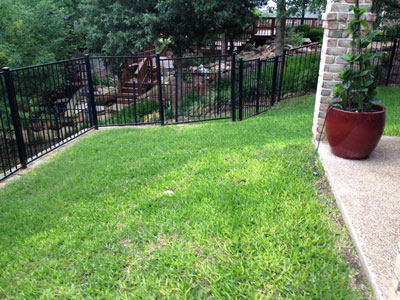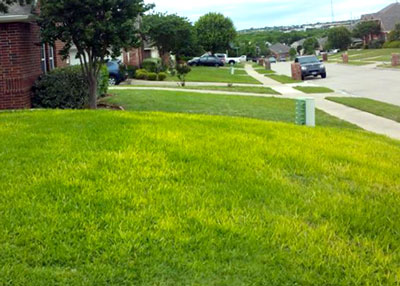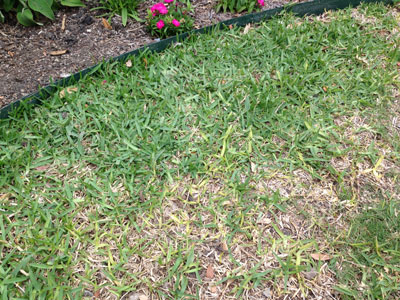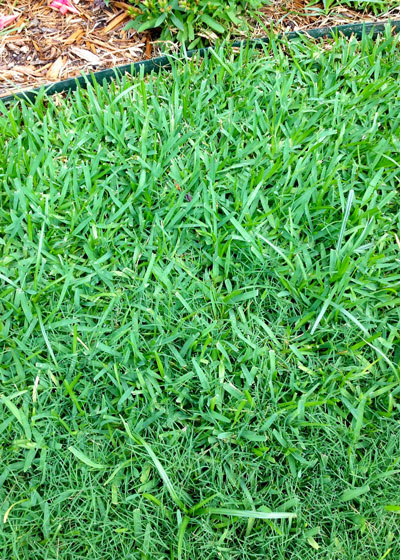Take All Root Rot Is Back

Take all root rot first shows as areas of yellowed grass in April, May.
It was the late 1990s and a new disease was being reported in St. Augustine in Texas. It went by the name of take all root rot or take all patch. It was becoming more widespread, and pathologists and turf experts were alerting us that it posed some real issues.

As TARR gets worse, lawn becomes more and more yellowed. Fertilizer, however, does not help. This photo was posted to my Facebook page a couple of years ago.
Then I began to see it in my own lawn. My callers and readers started asking about problems they were having. It was happening more and more often. I realized it was a real deal. So all that behind me, here are the facts and quick tips I’ve assembled over the years.
Symptoms…
• St. Augustine is slow to green up in the spring (April and early May).
• There are “washes” of yellowed turf across infected lawns. Certainly not in circles or any regular pattern, but very visibly different from the healthy areas.
• In cases of severe infection the grass actually dies.
• When you pull on the runners of infected grass they come loose from the soil very easily. Roots have been lost, much as if grub worms have been feeding on them. However, in digging in affected areas you rarely find grub worms.
The remedy – what was discovered…
Through the research work of my friend Dr. Phil Colbaugh, now retired from the Texas Agricultural Experiment Station of TAMU and others, and embellished with my own observations in the ensuing years:
• Fungicides proved to be of little value. They really weren’t all that effective.
• The fungus seemed to be most active in an alkaline environment such as would be found along I-35 and westward.
• Spreading of a 1-inch layer of any brand of sphagnum peat moss , Dr. Colbaugh found, repressed the disease and allowed infected grass to recover within just a couple of weeks. It greened up and started to grow almost as if it had been fertilized.

Before

After
Photos: “Before” and “after” photos show the dramatic turnaround treatment with just peat alone can make.
• One application seemed to work for one or more years.
• The disease is primarily active in the spring, so the peat treatment should be made by early to mid-May if it’s going to be of most benefit.

Before

After
Photos: Closer inspection of the infected areas shows even more clearly how much impact the simple treatment of sphagnum peat moss had on St. Augustine within just three weeks. This was on the Sperry lawn, so I witnessed this first-hand.
• Burst open the bales of sphagnum peat with a shovel and rake and spread it 1 inch deep over the infected areas. Use a garden rake turned upside-down to filter the peat through the blades and onto the soil surface.
• Water the lawn immediately to hold the peat in place.
• Human nature being what it is, you’ll be nervous about mowing your lawn the first time after you apply the peat. Run the mower blade at a low speed and you’ll be just fine.
Note: People aren’t careful in reading the specifics of this disease and this treatment. The application of sphagnum peat moss to the lawn is only effective for take all root rot (TARR), and it must be made in April or May.
Finally, as fond as I am of St. Augustine for my own personal lawngrass, I do have to admit that this may be one problem too many for me to accept. Chinch bugs can be stopped with one round of insecticides in the middle of summer. Gray leaf spot, also in summer, can be avoided by not applying nitrogen mid-June until early September. Brown patch in the fall isn’t usually serious and is easily treated.
But this one is a big pile of problems, and until a resistant strain is developed, if someone tells me they’re tired of St. Augustine and all of its issues and that they want to switch over to Palisades or another good type of zoysia (assuming they have enough sunlight), I certainly can’t argue. I may persist a little bit longer with my old friend, but my patience is wearing a bit thin.
